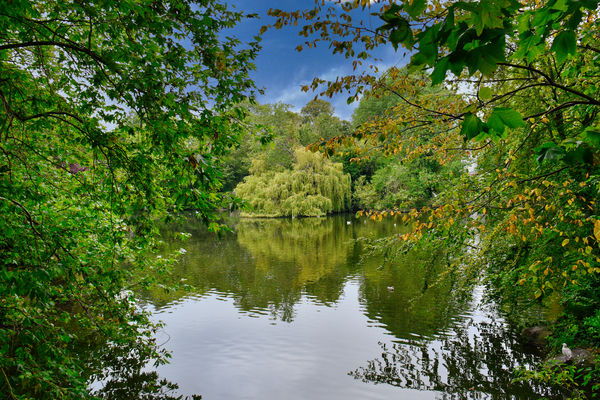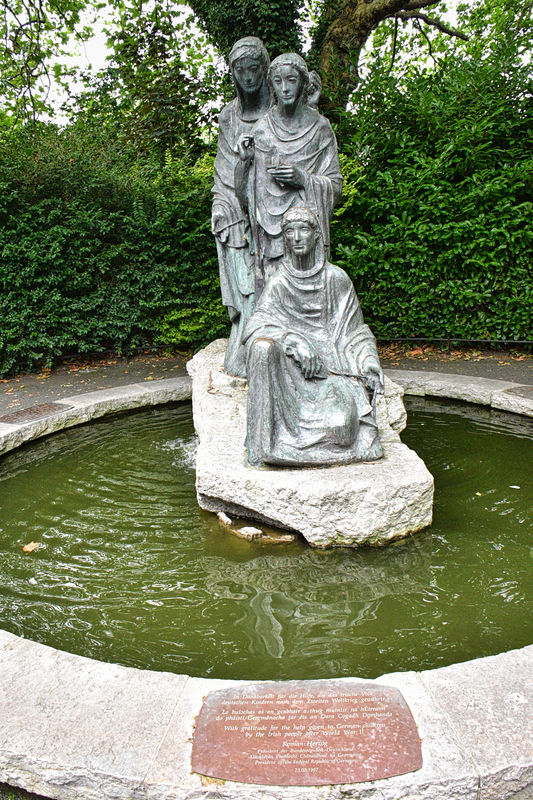Ireland: St. Stephen's Green, Dublin
May 17, 2020 18:01:07 #
St Stephen's Green (Irish: Faiche Stiabhna) is a city centre public park in Dublin, Ireland. The current landscape of the park was designed by William Sheppard. It was officially re-opened to the public on Tuesday, 27 July 1880 by Lord Ardilaun. The park is adjacent to one of Dublin's main shopping streets, Grafton Street, and to a shopping centre named for it, while on its surrounding streets are the offices of a number of public bodies as well as a stop on one of Dublin's Luas tram lines. It is often informally called Stephen's Green. At 22 acres (8.9 ha), it is the largest of the parks in Dublin's main Georgian garden squares. Others include nearby Merrion Square and Fitzwilliam Square.
Until 1663 St Stephen's Green was a marshy common on the edge of Dublin, used for grazing. In that year Dublin Corporation, seeing an opportunity to raise much-needed revenue, decided to enclose the centre of the common and to sell land around the perimeter for building. The park was enclosed with a wall in 1664. The houses built around the Green were rapidly replaced by new buildings in the Georgian style and by the end of the eighteenth century the Green was a place of resort for the better-off of the city. Much of the present-day landscape of the square comprises modern buildings, some in a replica Georgian style, and relatively little survives from the 18th and 19th centuries.
After the death of Prince Albert, Queen Victoria suggested that St Stephen's Green be renamed Albert Green and have a statue of Albert at its centre, a suggestion rejected with indignation by the Dublin Corporation and the people of the city, to the Queen's chagrin.
Access to the Green was restricted to local residents, until 1877, when Parliament passed an Act to reopen St Stephen's Green to the public, at the initiative of Sir A.E. Guinness, a member of the Guinness brewing family who lived at St Anne's Park, Raheny and at Ashford Castle. He later paid for the laying out of the Green in approximately its current form, which took place in 1880, and gave it to the Corporation, as representatives of the people. By way of thanks the city commissioned a statue of him, which faces the College of Surgeons. His brother Edward lived at Iveagh House, which his descendants gave in 1939 to the Department of External Affairs (now the Department of Foreign Affairs).
During the Easter Rising of 1916, a group of insurgents made up mainly of members of the Irish Citizen Army, under the command of Commandant Michael Mallin, his second-in-command Kit Poole, and Constance Markievicz, established a position in St Stephen's Green. They numbered between 200 and 250. They confiscated motor vehicles to establish road blocks on the streets that surround the park, and dug defensive positions in the park itself. This approach differed from that of taking up positions in buildings, adopted elsewhere in the city. It proved to have been unwise when elements of the British Army took up positions in the Shelbourne Hotel, at the northeastern corner of St Stephen's Green, overlooking the park, from which they could shoot down into the entrenchments. Finding themselves in a weak position, the Volunteers withdrew to the Royal College of Surgeons on the west side of the Green. During the Rising, fire was temporarily halted to allow the park's groundsman to feed the local ducks.
The park is now operated by the Office of Public Works on behalf of the Irish state.
https://en.wikipedia.org/wiki/St_Stephen%27s_Green
We walked through this beautiful park from our hotel to Grafton Street which was diagonally opposite. None of these images were taken through the tour bus windows. I hope you enjoy them anyway.
Mark
Until 1663 St Stephen's Green was a marshy common on the edge of Dublin, used for grazing. In that year Dublin Corporation, seeing an opportunity to raise much-needed revenue, decided to enclose the centre of the common and to sell land around the perimeter for building. The park was enclosed with a wall in 1664. The houses built around the Green were rapidly replaced by new buildings in the Georgian style and by the end of the eighteenth century the Green was a place of resort for the better-off of the city. Much of the present-day landscape of the square comprises modern buildings, some in a replica Georgian style, and relatively little survives from the 18th and 19th centuries.
After the death of Prince Albert, Queen Victoria suggested that St Stephen's Green be renamed Albert Green and have a statue of Albert at its centre, a suggestion rejected with indignation by the Dublin Corporation and the people of the city, to the Queen's chagrin.
Access to the Green was restricted to local residents, until 1877, when Parliament passed an Act to reopen St Stephen's Green to the public, at the initiative of Sir A.E. Guinness, a member of the Guinness brewing family who lived at St Anne's Park, Raheny and at Ashford Castle. He later paid for the laying out of the Green in approximately its current form, which took place in 1880, and gave it to the Corporation, as representatives of the people. By way of thanks the city commissioned a statue of him, which faces the College of Surgeons. His brother Edward lived at Iveagh House, which his descendants gave in 1939 to the Department of External Affairs (now the Department of Foreign Affairs).
During the Easter Rising of 1916, a group of insurgents made up mainly of members of the Irish Citizen Army, under the command of Commandant Michael Mallin, his second-in-command Kit Poole, and Constance Markievicz, established a position in St Stephen's Green. They numbered between 200 and 250. They confiscated motor vehicles to establish road blocks on the streets that surround the park, and dug defensive positions in the park itself. This approach differed from that of taking up positions in buildings, adopted elsewhere in the city. It proved to have been unwise when elements of the British Army took up positions in the Shelbourne Hotel, at the northeastern corner of St Stephen's Green, overlooking the park, from which they could shoot down into the entrenchments. Finding themselves in a weak position, the Volunteers withdrew to the Royal College of Surgeons on the west side of the Green. During the Rising, fire was temporarily halted to allow the park's groundsman to feed the local ducks.
The park is now operated by the Office of Public Works on behalf of the Irish state.
https://en.wikipedia.org/wiki/St_Stephen%27s_Green
We walked through this beautiful park from our hotel to Grafton Street which was diagonally opposite. None of these images were taken through the tour bus windows. I hope you enjoy them anyway.
Mark

(Download)

(Download)

(Download)

(Download)

(Download)
The Three Fates Fountain - From Norse Mythology

(Download)

(Download)

(Download)

(Download)

(Download)
May 17, 2020 18:06:22 #
May 17, 2020 18:31:56 #
UTMike wrote:
Another excellent tour, Mark! How long were you there?
Thanks Mike. We just spent 3 days in Dublin total but one was the day we arrived which was pretty much shot. We could have spent a few more days there and explored in depth, but our tour was pretty comprehensive as you'll see in upcoming posts.
May 17, 2020 22:32:40 #
Beautifully done, Mark. And once again; thanks for the narrative. I'm glad you got off the bus for these.
May 18, 2020 07:34:01 #
May 18, 2020 08:01:16 #
May 18, 2020 08:02:34 #
May 18, 2020 08:44:39 #
May 18, 2020 10:07:39 #
May 18, 2020 10:08:46 #
srfmhg wrote:
St Stephen's Green (Irish: Faiche Stiabhna) is a c... (show quote)
great set, mark. I love those beautiful circular flower beds!

May 18, 2020 11:26:33 #
May 18, 2020 13:04:48 #
May 18, 2020 14:41:07 #
Excellent and very enjoyable set Mark, the gardens are beautiful. Enjoyed reading the history. 



May 18, 2020 14:45:35 #
kpmac wrote:
Beautifully done, Mark. And once again; thanks for the narrative. I'm glad you got off the bus for these.
Thanks Ken. You must stretch the old legs periodically!


May 18, 2020 14:46:11 #
Bob Mevis wrote:
Beautiful shots. Looking forward to more.
Thank you very much Bob.
If you want to reply, then register here. Registration is free and your account is created instantly, so you can post right away.










